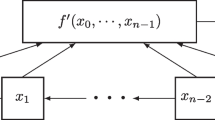Abstract
Many proposals of pseudorandom sequence generators and stream ciphers employ linear feedback shift registers with dynamic feedback (DLFSR) as the main module to increase the period and linear span of the involved m-sequences. In this paper, we present a theoretical model that allows the design of longer sequences with higher linear span than in previous DLFSR schemes. The model determines the constant relationship between period and linear span for these structures. These more complex sequences here obtained improve the proposals based on LFSR with dynamic feedback found in the literature.
Access this chapter
Tax calculation will be finalised at checkout
Purchases are for personal use only
Preview
Unable to display preview. Download preview PDF.
Similar content being viewed by others
References
Babbage, S., Dodd, M.: The MICKEY Stream Ciphers. In: Robshaw, M., Billet, O. (eds.) New Stream Cipher Designs. LNCS, vol. 4986, pp. 191–209. Springer, Heidelberg (2008)
Bogdanov, A., Preneel, B., Rijmen, V.: Security Evaluation of the K2 Stream Cipher. Internal report, Katholieke Universiteit Leuven, ESAT/SCD-COSIC (March 2011)
Che, W., Deng, H., Tan, X., Wang, J.: Networked RFID Systems and Lightweight Cryptography. In: Random Number Generator for Application in RFID Tags, ch. 16, pp. 279–287. Springer, Heidelberg (2008)
Cid, C., Kiyomoto, S., Kurihara, J.: The rakaposhi Stream Cipher. In: Qing, S., Mitchell, C.J., Wang, G. (eds.) ICICS 2009. LNCS, vol. 5927, pp. 32–46. Springer, Heidelberg (2009)
Ding, L., Guan, J.: Cryptanalysis of Mickey family of stream ciphers. Security and Communication Networks (6), 396–941 (2013)
Golomb, S.W.: Shift-Register Sequences, revised edn. Aegean Park Press, Laguna Hill (1982)
Gong, G.: Theory and Applications of q-ary interleaved sequences. IEEE Transactions on Information Theory 41(2), 400–411 (1995)
Hellebrand, S., Rajskia, J., Tarnick, S., Venkataraman, S., Courtois, B.: Built-in test for circuits with scan based on reseeding of multiple-polynomial linear feedback shift registers. IEEE Trans. Comput. 44, 223–233 (1995)
Kiyomoto, S., Tanaka, T., Sakurai, K.: K2: A stream cipher algorithm using dynamic feedback control. In: Hernando, J., Fernández-Medina, E., Malek, M. (eds.) SECRYPT, pp. 204–213. INSTICC Press (2007)
Meliá-Seguí, J., García-Alfaro, J., Herrera-Joancomartí, J.: J3Gen: A PRNG for Low-Cost Passive RFID. Sensors 13, 3816–3830 (2013)
Meliá-Seguí, J., García-Alfaro, J., Herrera-Joancomartí, J.: A practical implementation attack on weak pseudorandom number generator designs for EPC Gen2 Tags. Wirel. Pers. Commun. 59, 27–42 (2011)
Mita, R., Palumbo, G., Pennisi, S., Poli, M.: Pseudorandom bit generator based on dynamic linear feedback topology. Electronic Letters 38(19), 1097–1098 (2002)
Orumiehchiha, M.A., Pieprzyk, J., Shakour, E., Steinfeld, R.: Security Evaluation of Rakaposhi Stream Cipher. In: Deng, R.H., Feng, T. (eds.) ISPEC 2013. LNCS, vol. 7863, pp. 361–371. Springer, Heidelberg (2013)
Peinado, A., Fúster-Sabater, A.: Generation of pseudorandom binary sequences by means of LFSRs with dynamic feedback. Mathematical and Computer Modelling 57(11-12), 2596–2604 (2013)
Rosinger, P., Al-Hashimi, B., Nicolici, N.: Dual multiple-polynomial LFSR for low-power mixed-mode BIST. In: IEEE Proc. Comput. Digital Tech., vol. 150, pp. 209–217 (2003)
Author information
Authors and Affiliations
Corresponding author
Editor information
Editors and Affiliations
Rights and permissions
Copyright information
© 2014 Springer International Publishing Switzerland
About this paper
Cite this paper
Peinado, A., Munilla, J., Fúster-Sabater, A. (2014). Improving the Period and Linear Span of the Sequences Generated by DLFSRs. In: de la Puerta, J., et al. International Joint Conference SOCO’14-CISIS’14-ICEUTE’14. Advances in Intelligent Systems and Computing, vol 299. Springer, Cham. https://doi.org/10.1007/978-3-319-07995-0_39
Download citation
DOI: https://doi.org/10.1007/978-3-319-07995-0_39
Publisher Name: Springer, Cham
Print ISBN: 978-3-319-07994-3
Online ISBN: 978-3-319-07995-0
eBook Packages: EngineeringEngineering (R0)




